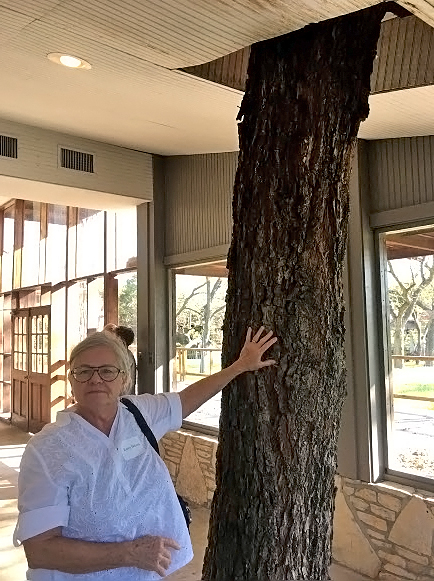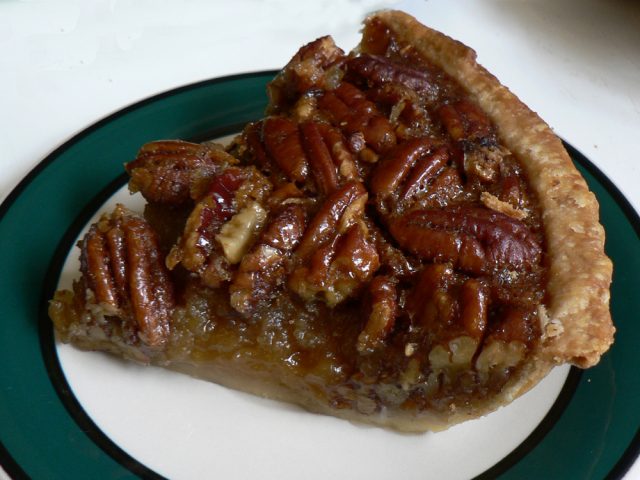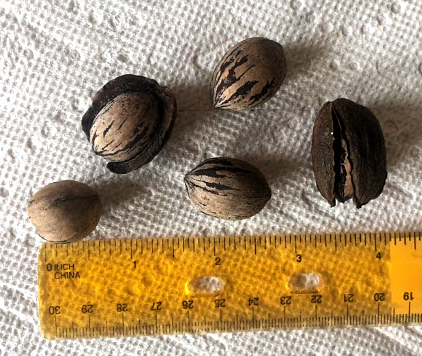
Rather than cut down all the old trees in a pecan grove in the Hill Country, the owners decided to incorporate this pecan tree into an event pavilion. This tree and its neighbors produced a hail of nuts on the tin roof when a “norther” hit. Robert Benson photo.
25 Nov 2016 – A Hail of Nuts Awakens Gatherer Instincts
The first big norther of the winter blew in last Saturday. Did you notice? My husband and I were attending a Texas Agri-Life seminar in the Hill Country. The site of the event was a big tin roofed pavilion on the banks of Onion Creek. Suddenly, the doors blew open and a deafening hail rattled on the roof. Everyone forgot the speaker for a moment and went to look for piles of ice outside.
There was no ice, no hail. What was going on? Then we noticed that we were in a pecan grove. All those leafless trees outside the pavilion were decades-old pecan trees. The wind had just knocked the remaining nuts off their limbs on to the tin roof.
I went into gatherer mode instantly. (Actually, I had the grace to wait until the coffee break.) The pecans were all over the grass and patio. I had overlooked them earlier because the nuts were rather small. I gathered a handful and cracked a few. Tiny but pretty tasty!

Chances are a slice of pecan pie is in your future (or in your recent past!) this Thanksgiving. The treat is a perennial favorite and it is even more delicious if you have gathered and cracked the pecans yourself. Wikimedia Commons photo.
My pecan gathering instinct was cultivated in me by my grandmother. Each autumn she took her grandchildren to Firemen’s Park (in Brenham, Texas) where we collected pecans. There were at least 10 trees in the park that produced very good nuts. I suspect they were all native pecans, not hybrids or grafted trees. Most of the pecans were small and some were very small! Our favorite was the big tree that produced an abundance of tiny pecans, each about the size of the tip of a pinkie finger.
The lovely fall afternoon we’d spent gathering pecans was just the beginning of the tradition. A day or two later, all the kids were assembled at Grammy’s kitchen table for an afternoon of pecan cracking. The biggest challenge was cracking those little pecans. They were hard-shelled but absolutely packed with the best-tasting nut meats. Every corner of space inside those shells was crammed with the tender pecan flesh. You could not push a pick or even a fingernail between the meat and the shell. But we kids had nimble fingers and extracted a good bit of the prime nut bits. As a reward we were allowed to eat any nut bit we winkled out, but never any from the bowl!
The nuts in that big bowl were destined for the treat of the season: pecan pie! The best pecan pie was the one at my grandmother’s table. It was the one made from pecans you personally had gathered, cracked and shelled.
Pecans are native to the eastern part of the United States and the river courses of south Texas and Mexico. They have long been a staple in the diets of wildlife and Native Americans. The Algonquin word, paccan, which means “any nut you need a stone to crack”, is the source of our modern word, pecan.
Tribal peoples throughout the pecan tree’s range devoted time to gathering the nuts. As early as 1528, Cabeza de Vaca wrote about the value of pecans to the native people. In his journal, he described the Miriame Indians who lived near the Texas coast (but not on it). This tribe lived two months of the year camped under pecan groves. He said they spent the entire time cracking and eating pecans!

The pecans from these trees were small, averaging just over a half-inch long. The trees were most likely an old variety like Burkett, but may have been grown from native seedlings. These little pecans have the tastiest nutmeats, excellent for pecan pie. Karen Benson photo.
I can believe it. Pecans are a wonderful, staple food, containing over 70 percent fat (but it is in the form of healthy, unsaturated oil), and are high in protein but low in carbohydrates. They are rich in anti-oxidants and minerals. Still, a pound of pecans yields a whopping 3,633 calories! Graze on these for a couple of months in the fall and you’ll be prepared to survive the winter.
Pecan trees are highly variable in the size of the nuts and the shell thickness, as well as in taste. Settlers had favorite trees, but the planted nuts didn’t always breed true. For that you needed a way to “clone” individual trees. It wasn’t until the 1800s that successful grafting of a twig from a superior wild pecan on to a pecan seedling was invented. This was accomplished at Louisiana’s Oak Alley Plantation. The gardener was a slave, known only to us as Antoine.
Antoine’s grafted pecan trees made history at the Philadelphia Exposition in 1876 where the nuts were given the Best Pecan Exhibited award. This clone was named “Centennial” and is still available today.
In the century and a half since then, pecans have been selected, hybridized, and grafted ad infinitum. There are now over 1,000 different cultivars of pecan. A grower can select for large nut size, high protein, high kernel weight, paper thin shells, high production (every year instead of every other year crop), disease resistance, and a host of other characteristics.
But for me the deciding factor is taste. Some pecans just taste better than others. The pecans I gathered at the pecan grove last week reminded me of those pecans from my grandmother’s day. They tasted like Thanksgiving. They tasted like pecan pie!
Happy Thanksgiving!
If you would like to offer comments, please click through to the discussion page
